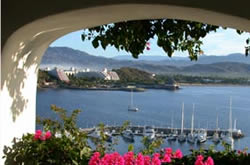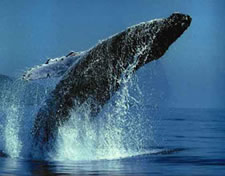
Manzanillo, Mexico - Charming Village on Pacific Coast of Mexico
by Renee Huang
 |
View
of Karmina Palace, from Puerto Las Hadas.
Photo courtesy Mexican
Pacific Marketing |
The
fishing line had been in the water for an hour
when it gave a jerk and the reel started whirring.
We
were aboard a tiny 30-foot sailboat on a pleasure
cruise to admire Manzanillo's undulating coastline.
Already,
we had come upon a pod of dolphins just offshore
in the deep blue Pacific as they cruised around
hunting fish. A few approached and swam alongside
the hull for a moment before turning abruptly
and moving off. For us, fishing was an afterthought.
But the rapidly spinning reel instantly called
our attention. The guys leaped into action and
fought to reel the thrashing fish toward us. As
it neared our boat, struggling fiercely and whipping
its tail out of the water, we were excited to
see we had snared a dorado, one of the tastiest
fish in the sea.
 |
|
The
colorful Dorado.
Photo by Renee Huang. |
Dorado
can weigh more than 50 pounds and are stunning
to see. This one was about three feet long, with
an iridescent yellow head and tail and a bright
blue and lime green body. The closer the dorado
got, the more fiercely it battled until at the
last second it gave one final leap. The hook snagged
on the boat, dislodged and the dorado slipped
away like a mirage to the groans of disappointment
from everyone on the boat.
Such
pure encounters with nature are common along this
stretch of Mexico's Pacific Coast. Despite weathering
a 7.8 earthquake in late January, Manzanillo's
tourist zone reported no major damage. The wide
sand beaches and hotels in the curved bays of
Manzanillo -- located between Puerto Vallarta
and Acapulco -- remain a gateway for adventurous
folk looking for untamed beauty and a plethora
of activities.
In
contrast to more developed resort playgrounds,
the pueblitos north of Manzanillo port
are pleasantly laid back and quaintly small-townish
and offer a wide selection of accommodations,
from humble hotels to luxury resorts.
Due
to the region's diverse topography and subtropical
climate, vegetation ranges from an arid, cactus-strewn
landscape during the dry months to lush, green
jungles during the rainy season, which runs from
June to October.Nowhere
else in Mexico does such a concentrated area shift
from desert to mountains, beaches to jungles,
and volcanoes to wetlands.
Our
encounter with the dorado was nothing new in these
parts. For years Manzanillo has hosted an annual
deep-sea fishing tournament in November. But that's
not all the area has to offer.
Snorkeling in the clear water reveals an abundance
of marine life including clown fish, puffers of
all sizes, moray eels, octopus, starfish, damsel
fish and enormous manta rays. Giant sea turtles
come ashore in the fall to lay eggs, which are
often eaten by gulls or poached for sale in markets.
At Cuyutlán Turtle Aquarium, guests learn
about preservation efforts and help return newborns
to the ocean.
Turtles
are not Manzanillo's only recurrent visitors.
We were on another fishing expedition, fingers
crossed for a close encounter with a marlin or
sailfish, when our captain excitedly pointed out
to sea, shouting, "Look! Whales!"
 |
|
Whales
near Manzanillo.
Photo courtesy Mexican Pacific Marketing |
No
more than 20 yards from our boat, we saw a plume
of cascading water and the distinct popping sound
of a blow hole releasing. The glistening backs
of two enormous California gray whales, fresh
from their annual journey down the Pacific Coast,
broke the water. They disappeared in a shallow
dive and resurfaced 100 yards away, backs rising
again before submerging completely, one flipping
us a wide tail in a farewell gesture.
Each
winter, California gray whales travel 5,000 miles,
the longest migration route of any mammal, from
Alaska to Mexico's Pacific where their calves
are born. Here, the mothers teach their young
to dive and to feed in the warm water. The calves
grow protective layers of blubber for their return
migration to Arctic waters which begins in late
January.
The
best time to see the marine giants, which can
measure 45 feet long, is in February and March,
when they are just off shore. Lucky boaters often
spot them breaching with thunderous splashes or
poking their heads out of the water and turning
slowly around to take a look, called "spy
hopping."
Manzanillo
offers a variety of other outdoor adventures.
On any given day, you can traipse from ocean to
off-road, snorkeling, peeking at birds in lagoons
or hitting the paths that wind through the foothills
of the Sierra Madre mountains. We visited a 100-foot
cascade called El Salto, and floated downstream
into an enchanting grotto with rocky ledges to
leap off and a smaller waterfall perfect for frolicking
under.
We
also spent an afternoon on a kayak tour of the
Centinela, a fresh-water lagoon near Manzanillo's
international airport amid creaking coconut groves
and lush banana plantations reminiscent of the
South Pacific. Our guide was Polo Ramirez, a local
restaurateur who also runs biking and kayaking
tours. As waves crashed on the beach on the other
side of the sand spit, we paddled in the lily-pad-covered
lagoon under the watchful eye of pelicans, who
sat motionless in the trees.
On
another cloudless day, Polo took us and some mountain
bikes to the dusty trails in Jalipa, a tiny town
15 minutes inland from Manzanillo. It took a few
minutes to grow accustomed to the trails, which
were covered with rocks and potholes. Once I did,
I was able to notice the amazing scenery: towering
palms wrapped in vines, gorgeous tropical flowers,
multicolored butterflies floating on the breeze.
We were in the heart of Mexico's coastal jungle.
The
terrain was pleasantly challenging, covering several
manageable hills. We also discovered the joy of
splashing through a couple of shallow streams.
At
one point, Polo stopped to pick up a wild, red-footed
tarantula the size of his palm, much to the horror
of several in our group.
"I
like tarantulas. I'm not scared of them. They're
my friends," he said, placing it on his bike
helmet before letting it scurry into the foliage.
We
breathed a sigh of relief. That was one new friend
we were happy not to make.
| IF
YOU GO... |
|
PLACES
TO STAY
- Kármina
Palace is a Mayan-style all-inclusive
resort in the Bay of Buena Esperanza with
suites ranging from $130-$425. Call toll-free
for reservations from the U.S at 1-877-KÁRMINA
or visit www.karminapalace.com.
- Las
Hadas is a mini-kingdom of white Moorish
buildings and cobblestone plazas brought
to fame by the Bo Derek movie "10".
Rooms rates start at $150. Call toll-free
for reservations at 1-888-559-4329 or
visit www.lasbrisas.com.mx/English/manzanillo.
ECOTOURS
AND ADVENTURE
- Mountain
biking, birdwatching and kayaking tours
are run by Polo Ramirez Rentaria (who
owns El Fogon steak house on the main
boulevard). Prices start at $50 per person
for transportation, equipment and snacks.
Call (011) (52) (314) 334-1166 or (011)
(52) (314) 333-1953 and ask for Polo or
Beinardo.
- Snorkeling,
scuba diving, fishing tours, whale watching
can be arranged through Hector Jimenez,
who has a watersports hut on the Las Hadas
beach.
Prices range from $40 for snorkeling and
$150 for a boat tour for the entire family
to $350 for a deep sea fishing tour. Call
his cell phone at (011) (52) (314) 335
743 87 or (011) (52) (314) 333-1848 to
book a tour.
WEB
SITES
www.mexicanpacific.com
www.gomanzanillo.com
|
|